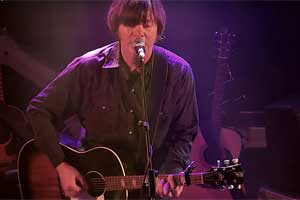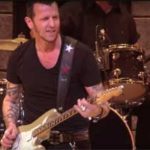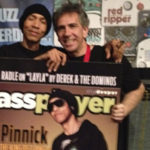Son Volt’s main man on the path to his new album and its Notes of Blue
By Gary Graff
February 17, 2017
When Uncle Tupelo broke up back in 1994, nobody was sure what lay ahead for the Americana group’s two principles. Both halves, it turns out, have thrived during the intervening years, and Jay Farrar quickly charged Son Volt into being. Starting with 1995’s Trace it’s been a diverse and versatile endeavor, with Farrar leading an array of lineups through alt.country, rock, honky tonk, Americana and a variety of other indigenous American roots styles.
The group’s just released new album, Notes Of Blue, lives up to its title with Farrar’s bluesiest outing yet, although the trio of influences he mines — Skip James, Mississippi Fred McDowell and Nick Drake — allow him to cut a wide swatch that makes it far more than just a blues album. It also lets Farrar strap on his electric guitar again after immediate predecessors such as 2013’s Honky Tonk and 2009’s rootsy American Central Dust. And rest assured he makes up for lost time, from the raw shuffle of “Sinking Down” to the ambience and texture in tracks such as “Lost Souls” and “Cairo and Southern.”
FGPO: It’s been nearly four years since the last Son Volt album. Does it feel like a minute to you?
Farrar: Yeah, kind of. There was a period in between where I was doing acoustic shows then the Son Volt Tracereissues were out. I think that sort of formed the perspective to get back to playing electric guitar and get Son Volt going on something new.
FGPO: There are fans who have been waiting for you to step into the blues like you do on Notes Of Blue. What made this the right time?
Farrar: I guess over the years I’ve kind of fallen into an approach that drills down a bit. I’ve always had one foot in a historical perspective to sort of learn about the elements that came to form the music that I’ve been playing and so forth. I’ve done a few blues-oriented songs over the years and I just wanted to focus a bit more on it this time.
FGPO: It’s an interesting group of sources you cite for this project, too.
Farrar: I felt like there was a certain mystique attached to the guitar tunings and guitar voicings of a couple of guys — Skip James, Fred McDowell and Nick Drake. At first those guys might seem a bit incongruous, but I was kind of working on two different projects at the same time — a Nick Drake, English folk-inspired project and also a more blues-oriented project. Ultimately I felt like there was a commonality of purpose there, a common ethic, especially in terms of finger picking being and alternative tunings being something they all used. Eventually both those projects just merged into one. I felt like there was a common aesthetic there. So this is like a tribute to those three guys and a chance to connect with icons and heroes.
FGPO: Where did you find the parallels?
Farrar: The Nick Drake tuning on the first song, “Promise The World,” is kind of a somber sounding tuning. Another tuning that would be an example would be the Skip James tuning, like on “Cherokee Street,” D-A-D-F-A-D. An example of the Fred McDowell tuning would be the song “Sinking Down,” which is an even lower tuning, C-G-C-E-G-C. Over the years I’ve grown to like working with alternate tunings. When you’re learning a different tuning everything seems new and you get the same kind of excitement you felt when you were first learning to play an instrument. You’re sort of revisiting that when you’re learning a new tuning and new chord configurations and hearing a new-sounding tuning.
FGPO: There are so many options and possibilities. Did it drive you crazy at all?
Farrar: Yeah, definitely. [laughs] The same thing that can open a lot of doors and provide a lot of different avenues to go down can also maybe spread you a bit far and wide. So sometimes I have to kind of remember standard tuning is there for a reason. It works.
FGPO: It’s not really a straight blues album, is it? It’s more of a blend.
Farrar: I was aiming for where blues and folk and country music converge. And I also wanted to get back to playing electric guitar. So that was a component also. Ultimately I see it as kind of a folk record, a rock record, elements of the blues, all of those things — even some garage rock in there.
FGPO: It’s a very cool tone you get on the electric guitars this time.
Farrar: I wanted to get back to playing electric guitar, and part of that meant bringing out the old Webster Chicago amplifier I used for the Son Volt record Trace — the amplifier on the cover of that record. It’s a low-powered amp that just delivers a big sound, and I just wanted to revisit the sound of that amp. It sort of represents a quintessential-sounding blues amplifier. Originally its life started out as an extension speaker for a wire recorder back in the 40s. I found it at a music shop in Los Angeles and someone had modified it to be a guitar amplifier.
FGPO: What kind of guitars are you playing on this album?
Farrar: I wanted to focus more on finger picking. I’ve spent the last maybe four years or so occasionally playing with pedal steel guitar, honky-tonk country type stuff, so I finally felt like I was ready to try and incorporate more finger picking throughout the record. In terms of specific guitars, I did play a bit of a bottleneck slide, which is not something I’ve done a lot of.
FGPO: Where does this drive come from the experiment and stretch out like you have?
Farrar: I think it just emanates from looking for ways to stay challenged, really. Like I said, when I’m learning something new it sort of takes you back to the same feeling and same thought process as when you first started to get involved in music. That’s pretty much what I want to try and keep doing.
FGPO: Do you tend to be reactive when you’re creating, to consciously — or unconsciously — veer in another direction from what you’ve just done?
Farrar: I think there’s something to that, yeah. With this record being comprised of alternate tunings, I’m looking for the next project to be back to standard tuning. I’ve written a fair amount of songs since November, so hopefully I’ll have time to get in the studio and record some new stuff.
FGPO: Talk about this particular lineup of Son Volt. It seems like a pretty flexible ensemble.
Farrar: It is. Some folks like Mark Spencer have been playing on and off with me for many, many years. He helped out playing bass and slide. Andrew Duplantis, we’ve played together for many, many years. And actually on tour with us this time is [guitarist] Chris Frame, who played with Son Volt during the Okemah and the Melody of Riot [in 2005] period. It’s a pretty solid and versatile group of guys.
FGPO: Because of all these different tunings, are the techs ready to string you up out there?
Farrar: Yeah, you’re definitely on to something there. [laughs] We’ve had some long talks and made charts and everything so we know what we need and when. It’s not easy.





